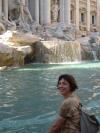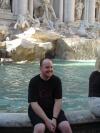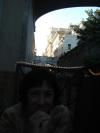Due Settimana in Italia
An Apolitical Travelogue
by Eric S. Piotrowski
Day Two: All Roads Lead to Rome
We arrived in Rome at 3:00 PM (or 15:00 in 24-hour time, which is standard in Italy). From the airport, a 20-minute train ride took us into the city itself. I'll say here that the trains in Italy are quite good. Someone has done a good job of making them run on time. Also, at the airport tracks, the thingy that makes the train stop looks like a spaceship.
We found our hotel with ease, despite the obscurity of street signs. (There's only one per block, and it's on the side of a building — you really have to hunt for it.) Diane was much better than I at finding them.
The hotel — despite being only one star — was very nice, although there was no AC (there was an oscillating floor fan, which we only appreciated when it vanished from later rooms) and the shower stall in the shared bathroom was tiny. It was about the same size as Bender's apartment.
Still tired but determined to hit the ground running, we headed off into the historical streets of Rome. Before long, we came to a piazza — you can't take three steps in Italy without emerging into one — containing a tower with a cross at the top and a very big building with a door guarded by men in sailor uniforms with guns. There was also a nice view of the city beyond, so we took a goofy picture (in which you can't see the view at all).
Walking in Rome is okay, but the cars are a bit insane. There's a lot of traffic, and drivers apparently get to choose which signs and lights they want to obey. To make things more interesting, the itty-bitty spaces between cars are filled with people on scooters zipping through.
Fortunately, Romans — unlike their American brethren — have recognized that their intense urban congestion means that smaller cars make life easier. Indeed, the tiny two-seat car pictured at right is not an uncommon sight on the street. (Any adult male driving such a vehicle in the US would doubtless have raw beef products and angry words about his sexuality hurled at him.)
Later in the day we found the famous Fontana di Trevi, known for its crucial role in cinema history — namely, the Mary Kate & Ashley Olsen direct-to-video film When in Rome. (And apparently it was also in some flick called La Dolce Vita.)
The fountain was quite impressive — statues, gold and water blend into a grandiose display. Alas, the impact was soiled a bit by the surly throng of tourists and the street vendors trying to hock their wares. The most idiotic and sonically disruptive of these was the gizmo that made a clacky-zapping sound when tossed into the air, which the vendors did constantly. Nothing says "Baroque monument to Neptune" quite like an insipid clacky-zapping noise.
Apparently there's an image of a little girl in the fountain (relating to the legend of she who first helped the Romans find a source of pure water), but we couldn't find it. Also — as you can see in the second picture — the fountain bears the name of my buddy Max.
After we had tossed our coins (you do this for luck — Wikipedia says 3,000 Euros are tossed in every day), we wandered around until we found a superb little restaurant. We ordered what we usually get at our favorite Madison Italian spot, Tutto Pasta: gnocci for Diane, spaghetti alle vongoli veraci for me. We did mix it up with fried veggies, though, and split a half-liter of wine. Between my exhaustion from the flight and general fatigue from hoofing it around the city, the wine clobbered me like a treno.
A complete reflection on the food of Italy is featured in the first interlude.
During the meal, I browsed the Italian phrase book and learned how to say "io no ho congelamento" (I do not have frostbite). Afterwards, we made our way back to the hotel and passed out. I tried reading a bit, but I didn't even make it through a page before I found myself slumped down in the text, head aslumber.











